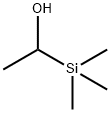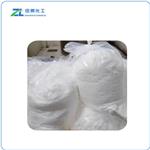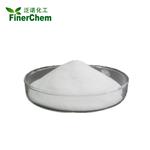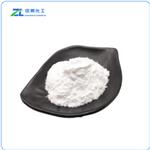Description
Glutaric acid is a dicarboxylic acid with carboxylic acid functional groups at either either end of the molecular chain. The terminal carboxylic acid groups can react with primary amine groups in the presence of activators (e.g. EDC, or HATU) to form a stable amide bond.
Chemical Properties
white or off-white crystals, usually containing 1mol crystal water. Soluble in water, alcohol, ether and chloroform, slightly soluble in petroleum ether.
Occurrence
Glutaric acid occurs in washings from fleece and, together with malonic acid, in the juice of unripened sugar beet.
Uses
Glutaric acid is used as the raw material for organic synthesis, pharmaceutical intermediate and synthetic resin. It serves as a precursor in the production of polyester polyols, polyamides, ester plasticizers and corrosion inhibitors. It is useful to decrease polymer elasticity and in the synthesis surfactants and metal finishing compounds. It acts as an intermediate during the catabolism of lysine in mammals.
Definition
ChEBI: glutaric acid is an alpha,omega-dicarboxylic acid that is a linear five-carbon dicarboxylic acid. It has a role as a human metabolite and a Daphnia magna metabolite. It is an alpha,omega-dicarboxylic acid and a dicarboxylic fatty acid. It is a conjugate acid of a glutarate(1-) and a glutarate.
Preparation
glutaric acid is produced as a by-product of the production process of adipic acid (about 2% of the output of an adipic acid plant is glutaric); Glutaric acid can be produced through various chemical routes, for example, from cyclopentane by oxidation with molecular oxygen and cobalt (III) catalysts or by ozonolysis; and from cyclopentanol–cyclopentanone by oxidation with oxygen and Co(CH3CO2)2, with potassium peroxide in benzene, or with N2O4 or nitric acid. Together with succinic acid, glutaric acid is formed as a by-product during oxidation of cyclohexanol–cyclohexanone in the adipic acid production process.
Application
The applications of glutaric acid, e.g., as an intermediate, are limited. Its use as a starting material in the manufacture of maleic acid has no commercial importance. it does not usually reach the market because it is converted into dibasic esters and sold as environmentally friendly solvents.
Synthesis Reference(s)
Journal of the American Chemical Society, 78, p. 2489, 1956
DOI: 10.1021/ja01592a042Organic Syntheses, Coll. Vol. 1, p. 290, 1941
Synthetic Communications, 10, p. 205, 1980
DOI: 10.1080/00397918008064223
General Description
Glutaric acid appears as colorless crystals or white solid. (NTP, 1992)
Air & Water Reactions
Water soluble.
Reactivity Profile
1,5-Pentanedioic acid is a carboxylic acid. Carboxylic acids donate hydrogen ions if a base is present to accept them. They react in this way with all bases, both organic (for example, the amines) and inorganic. Their reactions with bases, called "neutralizations", are accompanied by the evolution of substantial amounts of heat. Neutralization between an acid and a base produces water plus a salt. Carboxylic acids with six or fewer carbon atoms are freely or moderately soluble in water; those with more than six carbons are slightly soluble in water. Soluble carboxylic acid dissociate to an extent in water to yield hydrogen ions. The pH of solutions of carboxylic acids is therefore less than 7.0. Many insoluble carboxylic acids react rapidly with aqueous solutions containing a chemical base and dissolve as the neutralization generates a soluble salt. Carboxylic acids in aqueous solution and liquid or molten carboxylic acids can react with active metals to form gaseous hydrogen and a metal salt. Such reactions occur in principle for solid carboxylic acids as well, but are slow if the solid acid remains dry. Even "insoluble" carboxylic acids may absorb enough water from the air and dissolve sufficiently in 1,5-Pentanedioic acid to corrode or dissolve iron, steel, and aluminum parts and containers. Carboxylic acids, like other acids, react with cyanide salts to generate gaseous hydrogen cyanide. The reaction is slower for dry, solid carboxylic acids. Insoluble carboxylic acids react with solutions of cyanides to cause the release of gaseous hydrogen cyanide. Flammable and/or toxic gases and heat are generated by the reaction of carboxylic acids with diazo compounds, dithiocarbamates, isocyanates, mercaptans, nitrides, and sulfides. Carboxylic acids, especially in aqueous solution, also react with sulfites, nitrites, thiosulfates (to give H2S and SO3), dithionites (SO2), to generate flammable and/or toxic gases and heat. Their reaction with carbonates and bicarbonates generates a harmless gas (carbon dioxide) but still heat. Like other organic compounds, carboxylic acids can be oxidized by strong oxidizing agents and reduced by strong reducing agents. These reactions generate heat. A wide variety of products is possible. Like other acids, carboxylic acids may initiate polymerization reactions; like other acids, they often catalyze (increase the rate of) chemical reactions 1,5-Pentanedioic acid reacts with bases, oxidizing agents and reducing agents.
Fire Hazard
Flash point data for 1,5-Pentanedioic acid are not available; however, 1,5-Pentanedioic acid is probably combustible.
Flammability and Explosibility
Not classified
Purification Methods
Crystallise the acid from *benzene, CHCl3, distilled water or *benzene containing 10% (w/w) of diethyl ether. Dry it under vacuum. [Beilstein 2 IV 1934.]






